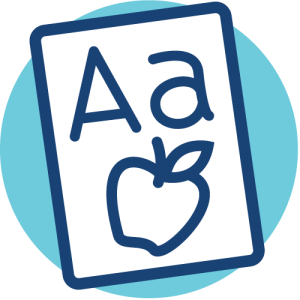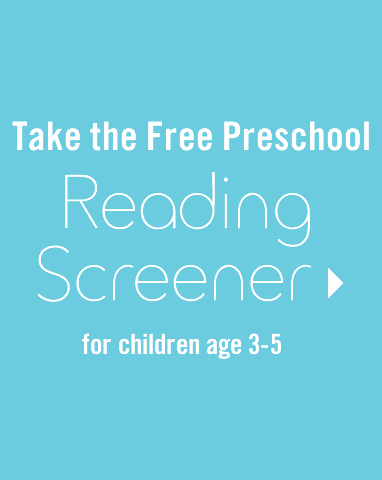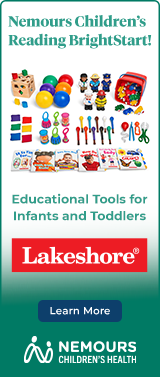 Letter Knowledge Includes:
Letter Knowledge Includes:
- recognition and naming of letter names and letter sounds
- general understanding of how print and pictures are processed differently
Some Key Letter Knowledge Skills:
- print awareness
- uppercase (capital) letter names
- lowercase (small) letter names
- letter sounds
Some Facts to Consider When Your Child is Learning to Read in English:
- There are 26 alphabet letters.
- Each letter has an uppercase and a lowercase letter, which means there are 52 shapes to remember.
- Along with recognizing 52 letter shapes, your child has to remember that each letter has a specific sound.
- The sounds for some letters are similar, making them easy to confuse.
- Some letters have more than one sound, like the vowels a, e, i, o, u, and some consonants, like c and g.
- Some letters make the same sound, like c and k.
- Some letters make more than one sound, depending on other letters they are paired with, like ch, sh, th, gh.
All of this makes learning letters challenging for young children. They need to learn, over time, to look at letters and listen to letter sounds differently and very carefully. For example, a truck is a truck, whether large or small, green or red, has four wheels or eight, is facing backward or forward, or is upside down or not. With letters, this is not true. We use an uppercase letter in some places, and a lowercase letter in other places. If we flip a ‘b’ one way, it becomes ‘d’; if we flip it another way, it becomes ‘p’ or ‘q’. Bring these differences to your child’s attention as you read together. Playing with letters and making their sounds will help.
Tips to Help Your Child Learn Letter Names and Sounds
- Provide many fun experiences with letter names and sounds, without adding stress or anxiety to remember them every time. When your child is first being introduced to letters, don’t be surprised if she knows the name of a letter or its sound one minute and then can’t remember it the next.
- “Show me the letter” is easier than “Tell me the letter.” Asking your child to point to or touch a letter is easier than asking him to tell you the name of the letter.
- Always end on a success. If your child does not know the letter name or letter sound, it is okay to tell him the answer and ask him to repeat it.
- Use your child’s own name to practice letter recognition. Children usually learn letters in their own names first.
- Limit the number of letters you introduce at one time. Presenting all 26 letters of the alphabet on the floor or table and asking your child to find the letter ‘b’ may be overwhelming and frustrating. Start off with two or three letters at a time as your child is learning.
- Letter reversals, such as mixing up the letters ‘b’ and ‘d’, are normal for preschool children. They are learning about spatial orientation as a critical feature for letter recognition and will gradually remember all the letters.
- Play with letters together. Provide choices of manipulative letters, such as ABC blocks, alphabet puzzles or magnetic letters. Give your child choices and chances to play with letters independently and creatively.
- Use “props” to search for letters. A pretend magnifying glass, plastic eyeglass frames or a large pretend ear can create fun opportunities to help your child remember to notice the details and important differences in how letters look and sound.
- Use multisensory teaching activities for helping your child learn letters.
Print Awareness
Print awareness relates to understanding that print and pictures are processed differently. We look at pictures. We read words. Think about how you look at a picture. Your eye will go to the focal point or the most interesting, colorful or meaningful place on the picture. When we read words or sentences in English, our eyes must be trained to start in a specific location and move from left to right. As the amount of print increases on a page, our eyes must not only move left to right but must also track the print to the next line, moving from the top of a page to the bottom.
In addition, a reader must:
- understand that a space between words shows where one word ends and the next word begins
- recognize and understand the meaning of punctuation marks
- in some languages, learn about marks that serve as pronunciation cues
Preschoolers don’t know all of these “rules” about written language. As you read with your preschooler, talk about the rules of print. Research shows that when you point to each word as you read, use punctuation to guide your voice and describe the print on a page, your child will grasp these important concepts and have increased reading success down the road.
Tips to Help Your Child With Print Awareness
- Point to words as you read them, moving your finger left to right and over the spaces.
- Ask your child to touch the words on a page or to show you a picture as you read together.
- Change your voice so that it sounds different when there is a period, a question mark or an exclamation point. Encourage your child to read the words in the same tone of voice.
- If your child is learning more than one language, be patient and supportive at all times. Remember that some languages are printed from right to left, or have different symbols and methods that represent how words are to be read.








